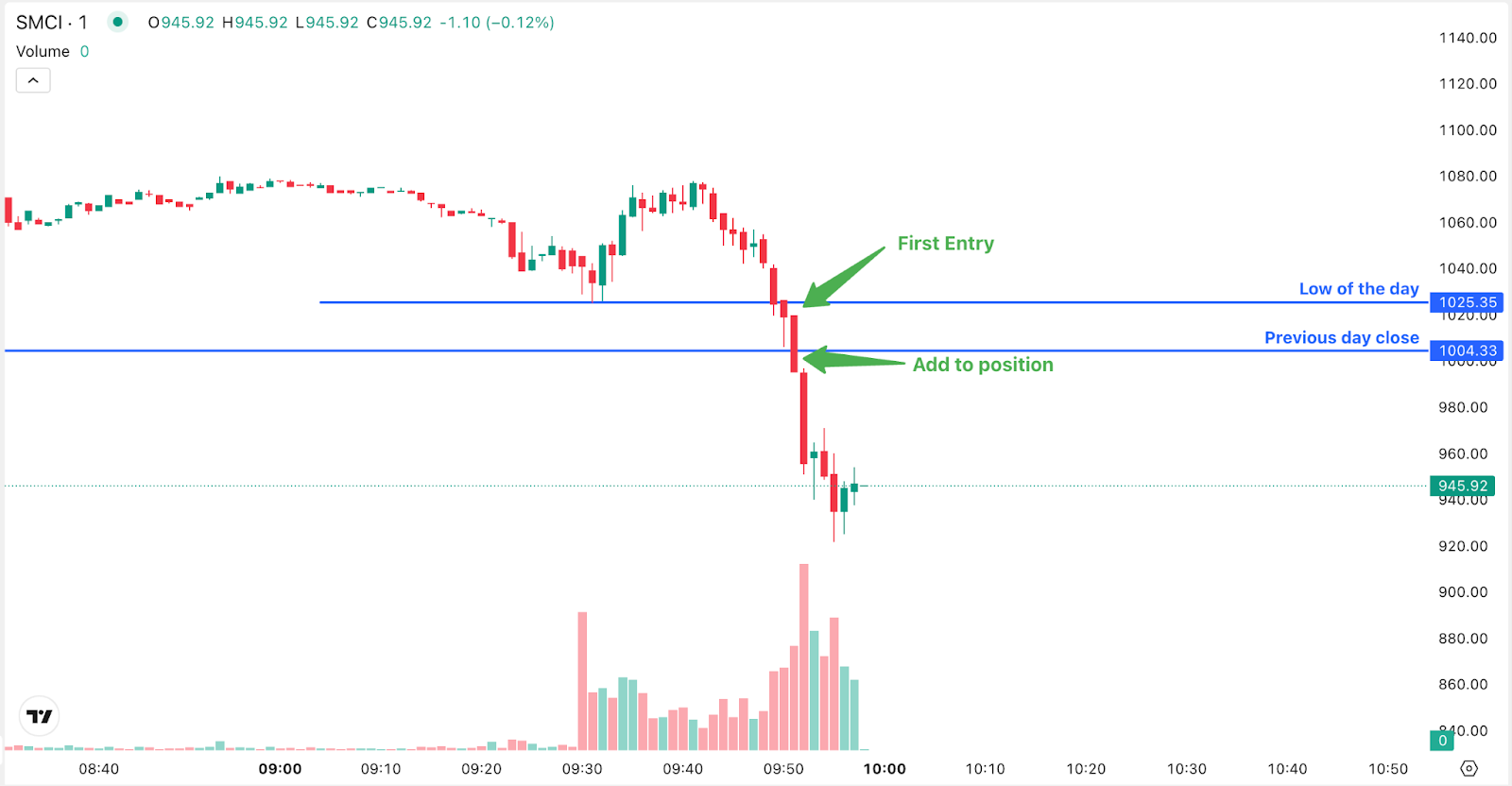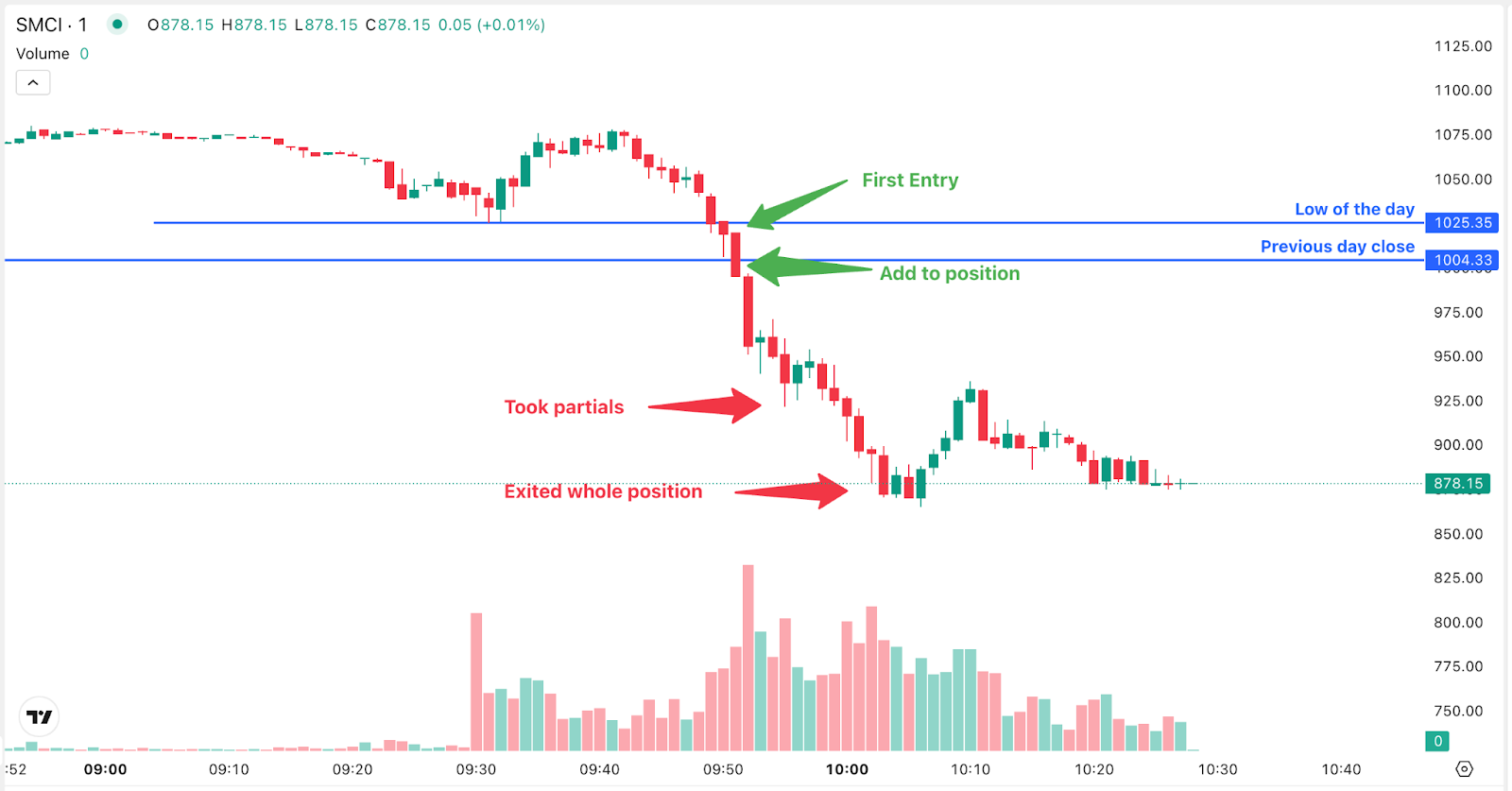Built For
Instruments: Stocks/Options
Trading Style: Day Trading
Playbook Overview
This playbook is built around one simple idea: stocks that go up like a rocket almost always come back down. The First Red Day setup focuses on finding a stock that has run up big for multiple days in a row and then catches the first day it closes red. That’s the day when momentum shifts, late buyers get stuck, and the drop can be fast and big.
This setup is repeatable because people always get greedy and chase at the top. This playbook breaks down exactly when and how to take advantage of that.
What This Setup Looks For
- A stock that moves up big for at least three days in a row. The bigger and faster the move, the better.
- A parabolic move, not just a slow trend up.
- The first day, it goes red compared to the previous day’s close.
- The cleanest setups gap up on the last day, push higher, then break red intraday.
- Sometimes the stock gaps down on the First Red Day instead — in that case, look for a bounce that fails near the previous close.
Playbook Rules
Confirm the Run
Look for a clear multi-day move. One green day is not enough. Two days is not enough. Three or more strong days, ideally with each day stronger than the last, is what you want. The run should look extended, stretched, with hype behind it.
Do Not Anticipate
Do not short too early just because you think it should come down. Many people lose by guessing. The key is waiting for confirmation — the stock must go red.
Mark the Previous Day’s Close
Draw a line at the previous day’s close. This is your key level. The trade does not start until the price goes under that line.
Plan for Two Ways It Can Set Up
- If it gaps up, best case. If it pushes higher at the open and then starts to fade, wait for it to break under the previous close. That’s the entry.
- If it gaps down, watch for a bounce back toward the previous close. If that bounce fails and price rejects that level, that’s your entry.
Starter and Add
Some traders use a small starter position if they see weakness setting up. But the main size is only added when the price confirms the break below red to green.
Stop Loss
Your entire idea depends on the stock going red and staying red. If the price reclaims the previous day’s close and holds above it, the setup is invalid. Cut the trade immediately
Take Partial Profits
As the stock drops, lock in gains by covering portions of your position into the weakness. Taking profits into the flush reduces stress and protects you if the stock bounces. If a bounce comes but the price stays under the previous close, you can re-enter or add size when the bounce fails.
Hold a Position
If the move is clear and momentum is broken, hold a small portion of the trade to catch any further drop. Once these overextended moves roll over, they often stay weak for days or weeks. Keeping a position lets you stay in the move without putting on more risk.
Why It Works
- Greed traps late buyers. Everyone thinks it will keep going forever.
- When momentum stalls, everyone who bought late wants out at once.
- Many stocks do dilutive offerings when extended, which adds selling.
- The panic builds on itself — the faster it drops, the more people sell.
- This setup keeps working because people always get greedy.
Pros and Cons of the Strategy
This playbook is designed to deliver high-quality, repeatable setups — but like any trading strategy, there are key things to understand before using it.
Note: The cons listed here aren’t disadvantages. They are things to be aware of — important characteristics that require patience, discipline, and proper management to make the strategy work effectively.
Pros
- Easy to Spot: The setup is easy to find. You just look for a stock that is up big for multiple days and wait for the first red day.
- Easy to Execute: There is a clear signal. You wait for the stock to trade below the previous day’s close. You don’t have to overthink or guess. You have the red-to-green line — that’s it.
- High Profit Potential:When the drop starts, it can move fast. A stock that runs up for days can give back a big chunk in one day. There’s a lot of room to make solid money if you catch it right.
- Works in Any Market: Human nature does not change. Greed repeats over and over. It works whether the market is up, down, or sideways. People always chase big moves.
- Clear Rules: You know when you’re right and you know when you’re wrong. If the stock goes red and stays red, you have a valid setup.
- Scalable: You can trade this with shares or with options if the stock has liquid options. With options, the return can be even bigger when the timing is right.
Cons
- Requires Patience: It does not happen every day. Sometimes you wait weeks or months for a clean setup. If you try to force it on small moves, you get chopped up.
- Easy to Jump Too Early: Many traders anticipate the top instead of waiting for the break. If you get in too soon and the stock keeps going, you lose or get squeezed out.
- Can Be Hard to Hold: The drop can bounce. If you do not take some off, you might panic when the price bounces back. Many traders cover too soon and miss the big part.
- Emotion Can Ruin It: If you miss it, you can get FOMO. If you mess up the first one, you might try to force the next trade. It is easy to break your plan if you are not patient.
- Must Respect the Stop: If the stock reclaims the red-to-green level and holds, you have to get out. Some traders hold and hope, then the loss grows fast.
- Gap Downs Have Less Room: If it gaps down instead of up, it can still work, but sometimes you don’t get as much range if you wait too long.
- Position Sizing Matters: If you go too big too soon, you might not be able to add size when it comes. The real edge is being able to scale in at the right spot.
Trade Breakdown
Trade Example — SMCI
Context: Big multi-day run with strong green days in a row. Stock gapped up again after multiple days of extension.
Plan: Wait for the stock to break below the previous day’s close. Mark the red-to-green line as the key level.

Entry:
- Opened with a small position when the stock broke below the low of day early.
- Added main size when the stock broke below the previous day’s close to confirm the First Red Day.

Move: After breaking the red-to-green line, the price dropped about $30 per share quickly. Partial were taken into the drop to lock in profit.

Details:
The stock opened with a gap up and showed strength at first.
- The early sign of weakness was the break below the day’s low — the first starter entry.
- The confirmation entry came when it broke under the previous close — the main signal for this setup.
Result: Profit locked in around $50,000 on this trade.











